Vermont is home to many species of birds, including the iconic red bird. These birds are a delight to watch and can be seen in many areas throughout the state. Redbirds are a species of Cardinal known for their bright red feathers and cheerful chirps.
They are common in backyards, parks, and woodlands all over Vermont and can often be seen perched in trees and shrubs. They are commonly found near bodies of water and feed on various fruits, seeds, and insects.
Redbirds are an essential part of the Vermont ecosystem, providing food sources for other wildlife and helping to keep pests in check. Despite their small size, these birds significantly impact the state’s ecology.
17 Red Birds in Vermont
In the heart of the northeastern United States lies Vermont, a state renowned for its picturesque landscapes, verdant forests, and vibrant wildlife. Among the myriad creatures that call this region home, birds stand out as both a symbol of natural beauty and a subject of scientific inquiry.
Here are 17 Red Birds in Vermont.
1. House Finch
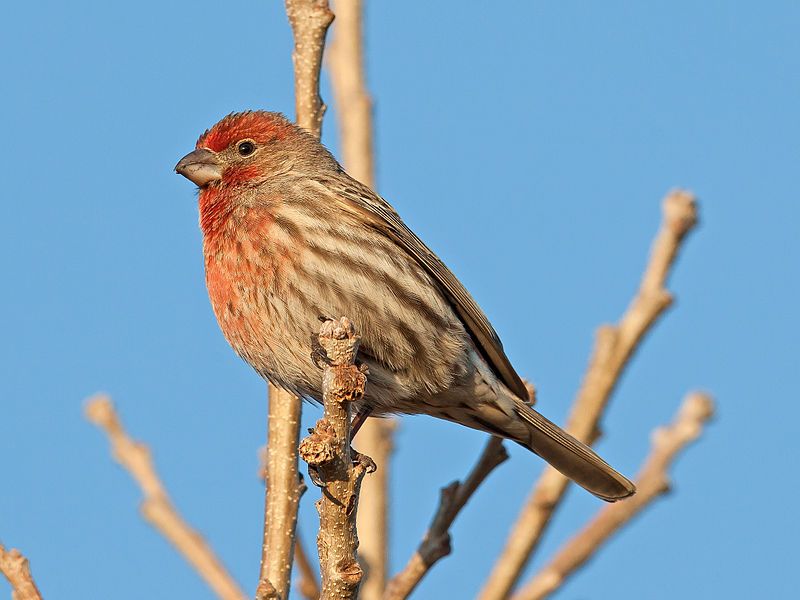
The house finch is a species of bird belonging to the finch family, Fringillidae. It’s native to western North America but has been introduced to the eastern half of the continent and Hawaii.
This species, along with two other American rosefinches, is part of the genus Haemorhous. The house finch is a small finch, typically measuring just over 4 inches in length and weighing between 0.5 and 0.8 ounces. It has a short, conical bill and a medium-length tail.
Its upperparts are greyish-brown with a pale rufous wash, while its underparts are white. The male house finch has a bright red forehead, crown, and throat, with a dark brown back.
The female house finch is less brightly colored, with a brownish-gray head, back, and wings, and white or pale pinkish underparts. The house finch is a social species, often seen in tight flocks, and it generally prefers open habitats, such as meadows and grasslands.
It feeds mainly on seeds and small insects, and its song is a pleasant, twittering trill.
| Kingdom | Animalia |
| Phylum | Chordata |
| Class | Aves |
| Order | Passeriformes |
| Family | Fringillidae |
| Genus | Haemorhous |
| Species | H. mexicanus |
2. Northern Cardinal
The Northern Cardinal is a type of bird that is known by many different names. It is often called the redbird, common Cardinal, red Cardinal, or simply cardinal, and it belongs to a genus of birds known as Cardinals.
This bird is native to parts of North America, and it is easily recognizable due to its vibrant red color. The male northern Cardinal has a bright red head, throat, and crest, while the female has a slightly duller color.
The Northern Cardinal is a songbird, and its melodious call can often be heard in backyards and wooded areas. This bird is also a popular choice among bird-watchers, as its bright red feathers make it easy to spot.
It is also a popular choice for people who feed birds, as it is one of the most common species that will visit bird feeders.
| Kingdom | Animalia |
| Phylum | Chordata |
| Class | Aves |
| Order | Passeriformes |
| Family | Cardinalidae |
| Genus | Cardinalis |
| Species | C. cardinalis |
3. Scarlet Tanager
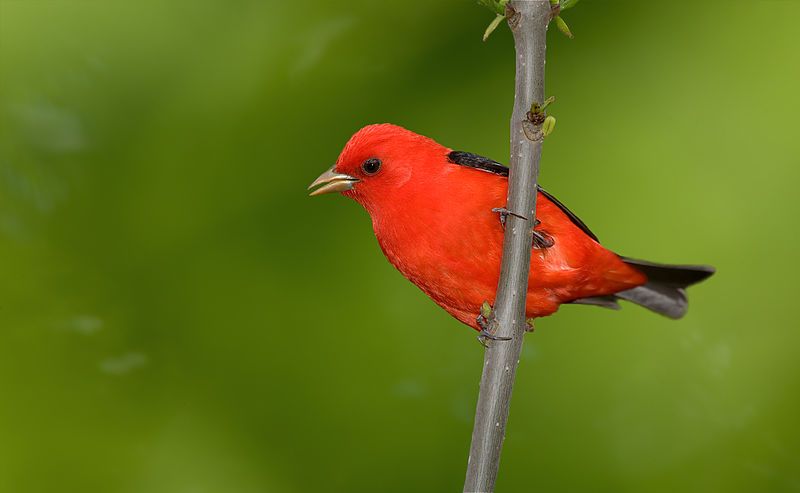
The scarlet tanager is a medium-sized American songbird that was traditionally classified as a member of the tanager family. Recent taxonomic reclassifications, however, have placed it in the cardinal family along with other members of its genus.
This reclassification is based on the fact that the scarlet tanager shares several critical traits with the members of the cardinal family, such as similar plumage patterns and vocalizations.
In addition, the scarlet tanager and the other members of its genus also have a more closely related genetic makeup than many other tanager species.
This new classification is an important step forward in recognizing the evolution of birds and the unique characteristics of each species.
| Kingdom | Animalia |
| Phylum | Chordata |
| Class | Aves |
| Order | Passeriformes |
| Family | Cardinalidae |
| Genus | Piranga |
| Species | P. olivacea |
4. Red Crossbill
The red crossbill, also known as the common crossbill, is a small songbird that belongs to the Fringillidae family, which is a group of finch species. This bird has a very distinct feature that sets it apart from other species: its mandibles are crossed at the tips.
This adaptation allows the red crossbill to extract seeds from conifer cones and other fruits, giving it a vast source of food. The red crossbill is an intriguing bird, as it has many unique adaptations that help it to survive.
It has a pointed beak that is adapted to pine cones and other fruits to get at the juicy seeds inside. Its crossed mandibles also allow it to hold onto the cone while it is extracting the seeds, giving it a tremendous advantage over other birds.
Another interesting adaptation of the red crossbill is the way it feeds. The bird often hangs upside down on conifer branches while foraging for food, using its crossed mandibles to pry open the pine cones and extract the seeds.
This technique allows the red crossbill to access food that other birds cannot reach.
The red crossbill is an impressive species that has adapted to survive in a wide range of habitats, from the northern coniferous forests of North America to the mountains of Eurasia and North Africa.
Its distinctive crossed mandibles make it a unique bias capable of foraging for food in ways other species cannot.
| Kingdom | Animalia |
| Phylum | Chordata |
| Class | Aves |
| Order | Passeriformes |
| Family | Fringillidae |
| Genus | Loxia |
| Species | L. curvirostra |
5. Common Redpoll
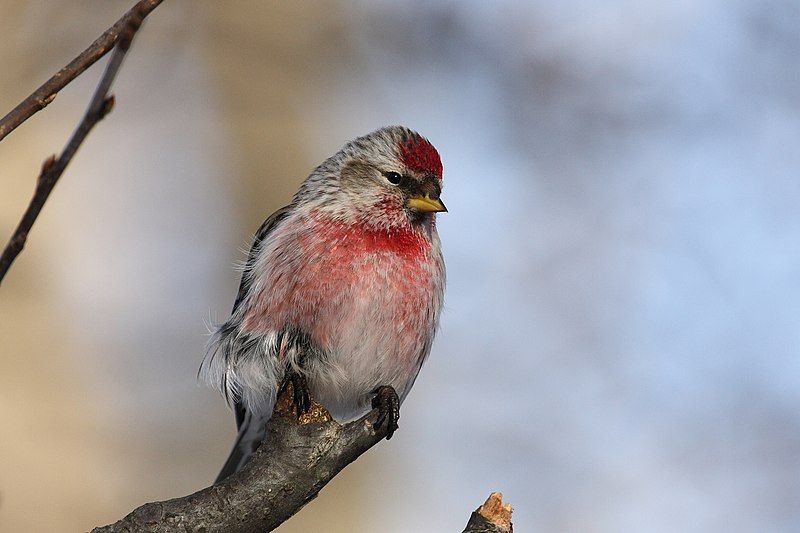
The common redpoll, also known as the mealy redpoll, is a species of bird in the finch family. This tiny bird is mainly found in the northern hemisphere, and breeds further south than the Arctic redpoll.
Its habitat usually consists of thickets and shrubs where it can find shelter and protection. The common redpoll is a small bird with a reddish-brown plumage and a yellow patch on its forehead.
Its wings are brownish-olive with white markings and its tail is dark above and white below. It also has a short, black bill and black legs. This species feeds mainly on seeds and the buds of shrubs and trees. It also eats insects, especially caterpillars in the summer.
The common redpoll typically lives in open fields, meadows, and coniferous forests. It is also known to inhabit parks and gardens. The common redpoll is generally a solitary bird, but they can often be seen in small flocks during their migrations.
They are also known to travel in large flocks when searching for food. The common redpoll is an important species, as it helps to disperse the seeds of various plants which helps in the regeneration of vegetation.
| Kingdom | Animalia |
| Phylum | Chordata |
| Class | Aves |
| Order | Passeriformes |
| Family | Fringillidae |
| Genus | Acanthis |
| Species | A. flammea |
6. Summer Tanager
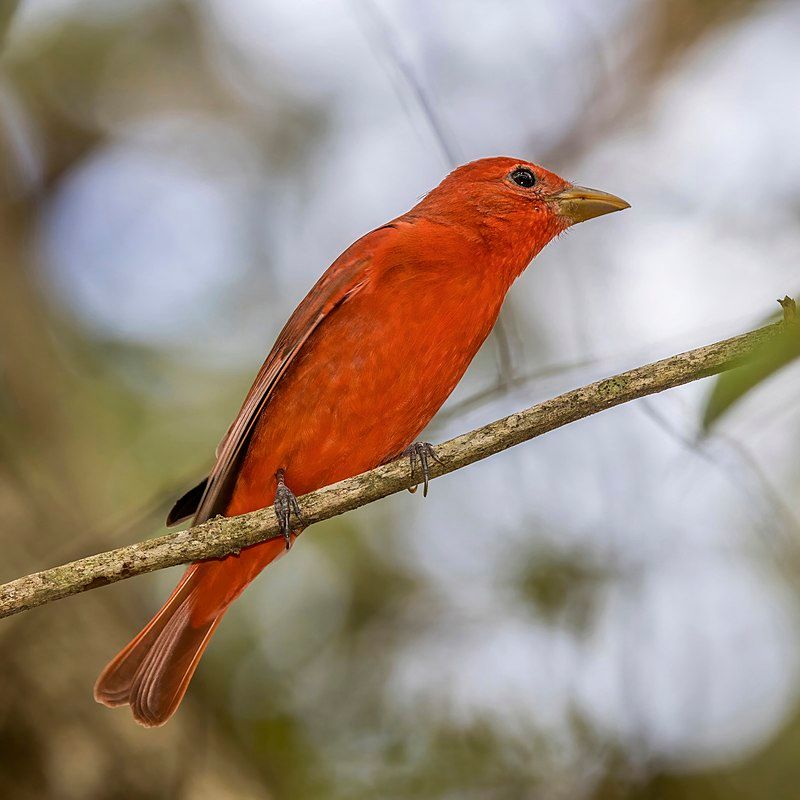
The summer tanager is a medium-sized American songbird that was traditionally part of the tanager family. However, recent studies have determined that the summer tanager and other members of its genus now belong in the cardinal family.
The summer tanager’s plumage and vocalizations are similar to other members of the cardinal family, making it easy to identify and distinguish from other birds in the same family.
The summer tanager has bright yellow feathers on its body and a red face with a slightly curved bill. The bird’s song is usually a series of short, high pitched notes that can be heard during the day.
In addition, the summer tanager often performs a courtship display with its wings spread, head thrown back, and tail spread. This behavior is expected in the cardinal family and provides further evidence that the summer tanager is part of this family.
| Kingdom | Animalia |
| Phylum | Chordata |
| Class | Aves |
| Order | Passeriformes |
| Family | Cardinalidae |
| Genus | Piranga |
| Species | P. rubra |
7. Two-Barred Crossbill
The two-barred crossbill is a small bird belonging to the finch family Fringillidae. It is found in North America and the Palearctic region. It is often called the ‘white-winged crossbill’ due to the white stripes that can be seen along its wings.
It is a passerine bird, meaning it is adapted to perching on branches or other structures. The two-barred crossbill is a species of coniferous forest specialist. This means it is especially adapted to living in and around coniferous forests, such as pine forests.
It is typically found in areas of high elevation, such as mountain ranges. This species of crossbill feeds on pine cones, and primarily eats the seeds inside.
It is also known to eat the sap from certain conifers, as well as some insects. The two-barred crossbill typically builds its nest in the coniferous trees it feeds on. It makes a cup-shaped nest in the branches and lines it with feathers or other materials.
The female usually lays two to three eggs and both parents take part in incubating them. The young fledge when they are about two weeks old. The two-barred crossbill is an essential species for the coniferous forests in which it resides.
It helps to spread the seeds of the trees, allowing them to regrow and keep the forests healthy. Unfortunately, this species is declining due to deforestation and other human activities. Conservation efforts are being made to help protect this species and its habitat.
| Kingdom | Animalia |
| Phylum | Chordata |
| Class | Aves |
| Order | Passeriformes |
| Family | Fringillidae |
| Genus | Loxia |
| Species | L. leucoptera |
8. Painted Bunting
The painted bunting is a species of bird from the cardinal family, Cardinalidae. It is native to North America and is known for its bright plumage, which the male primarily sports.
Interestingly, the males do not develop their bright plumage until their second year of life; in the first year, the only way to distinguish between a male and female is through close inspection. This is because the first-year birds have a more muted, subdued coloration.
The painted bunting is an iconic species of bird in North America, and it is known for its bright colors and unique patterning. The males are incredibly colorful and a favorite of bird-watchers and photographers alike.
| Kingdom | Animalia |
| Phylum | Chordata |
| Class | Aves |
| Order | Passeriformes |
| Family | Cardinalidae |
| Genus | Passerina |
| Species | P. ciris |
9. Red-Headed Woodpecker
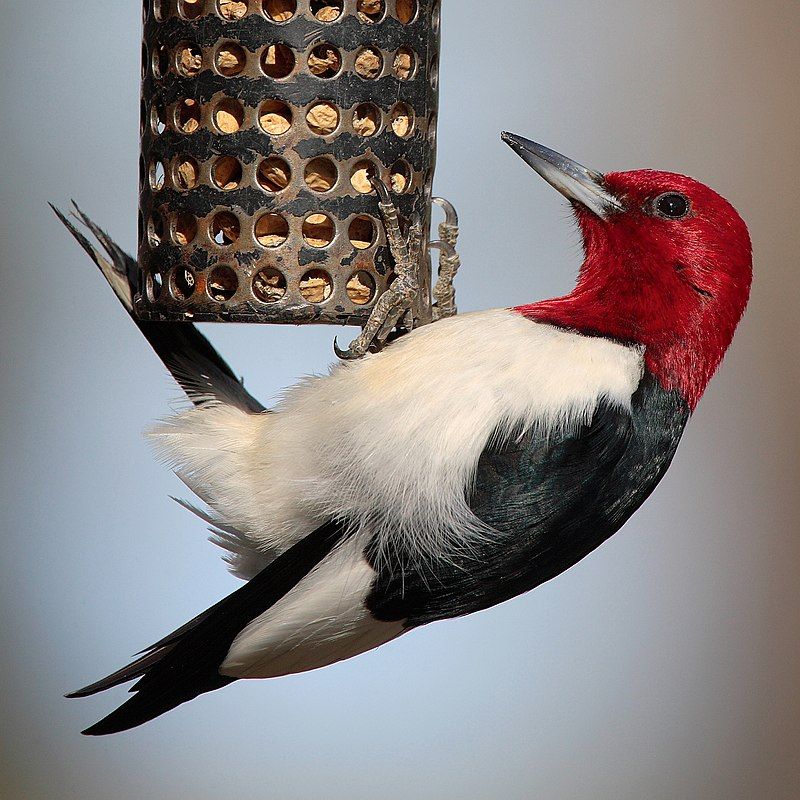
The red-headed woodpecker is a species of woodpecker native to temperate North America. It is considered a mid-sized woodpecker, with a length between 7.5 and 9.1 inches and a wingspan of 11.8 to 15 inches.
This species is most commonly found in open countries, which can span across the east-central United States. During the breeding season, this woodpecker is found in these areas.
Its diet mainly consists of insects and nuts, which it finds from tree bark, as well as fruit, berries, and seeds. It is also known to occasionally consume small amphibians, reptiles, and bird eggs.
This species is easily identified by its bright red head, white underparts, and black back and wings. This woodpecker is also known for its loud, distinctive call, which has been described as sounding like a “quick, loud laugh.”
| Kingdom | Animalia |
| Phylum | Chordata |
| Class | Aves |
| Order | Piciformes |
| Family | Picidae |
| Genus | Melanerpes |
| Species | M. erythrocephalus |
10. American Robin
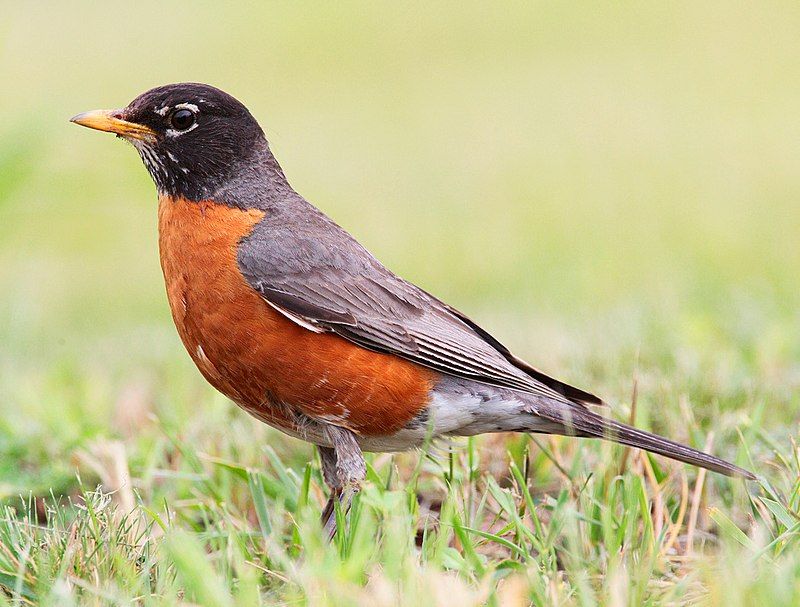
The American robin is a migratory bird belonging to the genus Turdidae, which is part of the wider thrush family. This species of bird got its name due to its resemblance to the European robin, which has a reddish-orange breast.
Despite the same coloration, the American and European robin are not closely related. European robins are of the Old World flycatcher family, while the American robins are of the valid thrush genus.
The American robin is a very popular bird in North America and is well known for its reddish-orange breast. It is also known for its migratory nature, as it moves south to warmer climates in the winter months.
The American robin is considered to be a songbird and is often seen in flocks of many birds. It is a common sight in most parts of the United States and Canada. The American robin is an omnivore and its diet consists of insects, worms, berries, and other fruits.
It is a common sight in residential gardens, where it feeds on insects, worms and berries. It is also known to forage in lawns, forests, and parks.
The American robin is an essential indicator of ecological health, as its presence is often seen as a sign of healthy ecosystems.
Overall, the American robin is an important species of bird that plays an important role in the North American environment. Its reddish-orange breast and migratory nature easily recognize iture.
Despite its resemblance to the European robin, the two species are not closely related, with the European robin belonging to the Old World flycatcher family.
| Kingdom | Animalia |
| Phylum | Chordata |
| Class | Aves |
| Order | Passeriformes |
| Family | Turdidae |
| Genus | Turdus |
| Species | T. migratorius |
11. Woodpeckers
The Picidae family is a large family of birds that consists of woodpeckers, piculets, wrynecks, and sapsuckers. This family of birds is found in many places around the world, with the exception of Australia, New Guinea, New Zealand, Madagascar, and the extreme polar regions.
Woodpeckers can be seen in forests, parks, and gardens. They have a unique way of searching for food, which involves using their strong beaks to peck at wood and bark to find insects. Piculets are smaller than woodpeckers and have a softer pecking sound.
They are usually found in the more tropical regions of the world. Wrynecks and sapsuckers are also members of the Picidae family, but they are not as commonly seen. Wrynecks feed on ants and other insects, while sapsuckers mainly feed on tree sap.
All these birds have adapted to their environments in different ways and live in a wide range of habitats.
| Kingdom | Animalia |
| Phylum | Chordata |
| Class | Aves |
| Order | Piciformes |
| Family | Picidae |
12. Downy Woodpecker
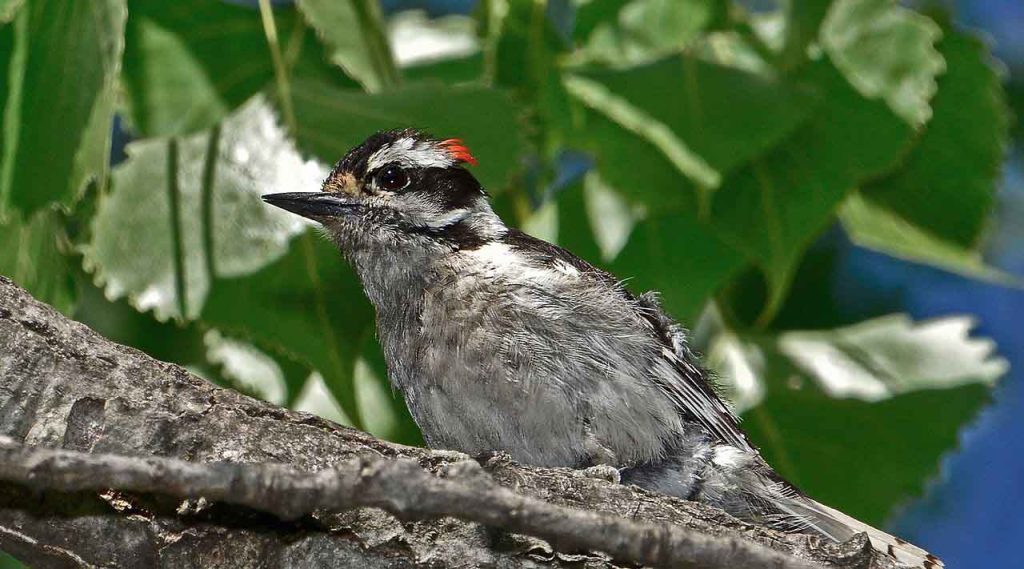
The Downy Woodpecker is a small species of woodpecker native to North America. It typically measures between 14 and 18 centimeters in length, making it the smallest of its kind in the continent.
This bird can be found in forested areas across the United States and Canada, but is not found in the dry deserts of the Southwest and the northern tundra regions.
Downy Woodpeckers are found in a variety of habitats including deciduous woods, coniferous woods, riparian woods, and urban woods.
It is also known to inhabit orchards, parks, and gardens. They feed primarily on insects, such as ants, beetles, and caterpillars, but they also eat nuts, fruits, and seeds.
Downy Woodpeckers often nest in trees, excavating a small hole for their eggs. The Downy Woodpecker is an integral part of the North American ecosystem.
It helps to control insect populations, and its presence is also beneficial to other birds, as its diet consists of mostly insects. Furthermore, it plays an essential role in dispersing various plants’ seeds, which helps maintain a healthy and diverse ecosystem.
| Kingdom | Animalia |
| Phylum | Chordata |
| Class | Aves |
| Order | Piciformes |
| Family | Picidae |
| Genus | Dryobates |
| Species | D. pubescens |
13. Red-Bellied Woodpecker
The red-bellied woodpecker is a species of woodpecker that belongs to the family Picidae, which includes all woodpeckers. This bird is an average-sized species that is mainly found in the eastern part of the United States.
Its range covers a large area, reaching as far south as Florida and as far north as Canada. This species of woodpecker is a common bird that can be found in many different types of habitats, such as deciduous, mixed, and coniferous forests.
It is also known to inhabit pastures, suburban areas, and parks. The red-bellied woodpecker is easily identified due to its distinct black, white, and red plumage. Its upperparts are black and white, and its underparts are red.
Its white throat and cheeks are also a key identifying feature. This species feeds mainly on insects, such as ants, beetles, and caterpillars, which it catches by pecking at the bark of trees.
It also enjoys eating seeds and fruits. The red-bellied woodpecker breeds mainly in the spring and summer months. During this time, the male and female will work together to build their nest in a tree cavity. The female will then lay between four to seven eggs.
Both parents will feed the young from the time they hatch until they are old enough to leave the nest. The red-bellied woodpecker is an essential species in its range and is protected by the Migratory Bird Treaty Act. It is also legally protected by the U.S.
Fish and Wildlife Service. Thanks to this protection, the population of this species has remained stable and is not currently considered threatened.
| Kingdom | Animalia |
| Phylum | Chordata |
| Class | Aves |
| Order | Piciformes |
| Family | Picidae |
| Genus | Melanerpes |
| Species | M. carolinus |
14. Red-Winged Blackbird
The red-winged blackbird is a species of bird that belongs to the Icteridae family. This bird can be found in most of North America and a large part of Central America.
They are a type of passerine bird, meaning they are perching birds with feet that have two toes pointing forward and two pointing backwards. Red-winged blackbirds are typically black in color, with bright red and yellow patches on their wings.
They have a long, slender beak and sharp claws for gripping branches when they perch. These birds typically live in wetlands, marshes, and grasslands, where they can find plenty of food.
They are omnivorous, eating a variety of insects, berries, grains, and other small animals. Red-winged blackbirds are very social birds and often form large flocks during migration.
In the months, they can be heard singing their loud, distinctive song from the tops of trees.
This song is composed of a variety of whistles, trills, and rattles. The red-winged blackbird is an essential species in its range, providing food for many other animals and helping to disperse seeds.
It also serves as an important indicator species, helping us to understand the health of the environment they inhabit.
| Kingdom | Animalia |
| Phylum | Chordata |
| Class | Aves |
| Order | Passeriformes |
| Family | Icteridae |
| Genus | Agelaius |
| Species | A. phoeniceus |
15. Northern Flicker
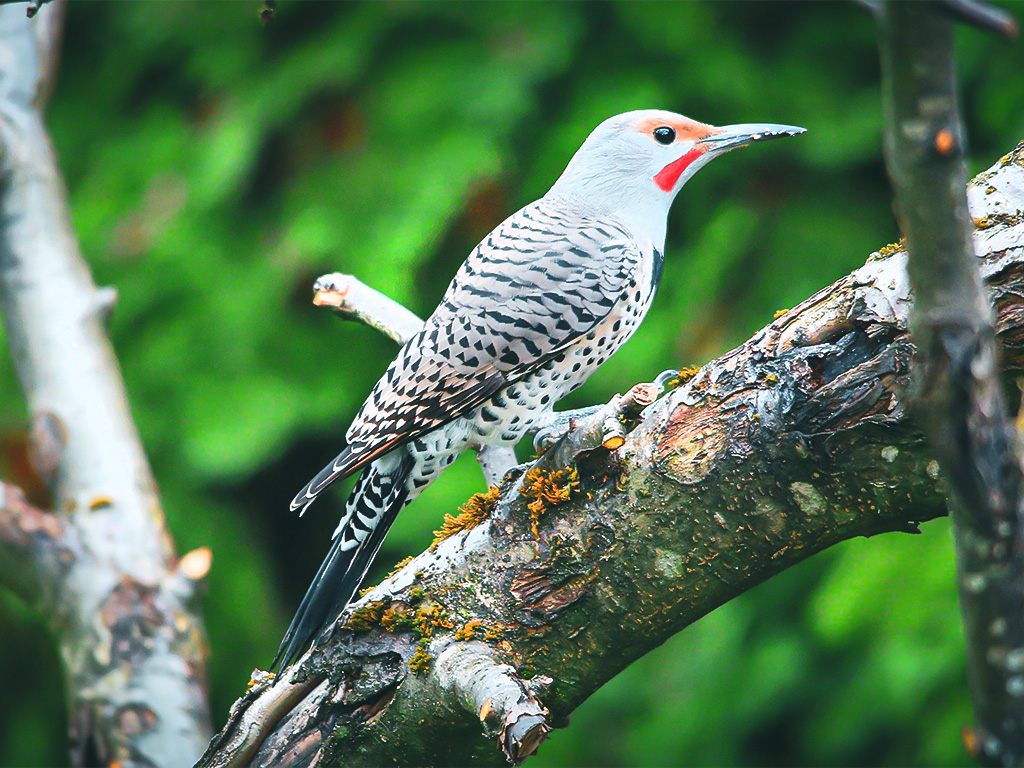
The northern flicker, also known as the familiar flicker, is a woodpecker species found in North America, Central America, Cuba, and the Cayman Islands. It is a medium-sized bird, with a length of around 15 to 20 inches, and a wingspan of 24 to 29 inches.
Its head and back are an attractive combination of black, brown, and white, with a white marking on the throat. The northern flicker is one of the few species of woodpeckers that migrate, usually travelling south in the winter months and returning north again in the spring.
It is an omnivore, eating seeds, berries, insects, and even small lizards. The northern flicker is also known for its loud call, which can be heard echoing through forests and wooded areas.
It is a fascinating species of bird and one that is important to the balance of the environment.
| Kingdom | Animalia |
| Phylum | Chordata |
| Class | Aves |
| Order | Piciformes |
| Family | Picidae |
| Genus | Colaptes |
| Species | C. auratus |
16. Pileated Woodpecker
The pileated woodpecker is a large species of woodpecker that is native to North America. It is primarily black, although its wings and tail show white bars and its head has a bright red crest. It is an insectivore, meaning its diet is mainly composed of insects.
It can be found in deciduous forests in eastern North America, the Great Lakes region, the boreal forests of Canada, and parts of the Pacific Coast.
The pileated woodpecker is the largest woodpecker in North America, measuring 16 to 19 inches in length with a wingspan of 26 to 30 inches. Its beak is long and chisel-like, and its strong legs and feet are well-adapted for clinging to tree trunks and branches.
Its plumage is primarily black, with white stripes on its wings and tail.
Its head has a bright red crest that can be raised or lowered when the bird is alarmed or excited. The pileated woodpecker is an expert forager and can often be seen hammering away at tree bark looking for insects. It is an active bird and can be seen in the flag for food.
It also creates large cavities in trees to make its nest. The cavities can be up to two feet deep and a foot wide, and can be used for many years by the same bird or different members of its species. The pileated woodpecker is an essential species in the North American ecosystem.
It plays a vital role in controlling insect populations, and its large cavities in trees provide nesting and roosting sites for other wildlife species. This species has been declining in some areas due to habitat destruction, but its population remains healthy overall.
| Kingdom | Animalia |
| Phylum | Chordata |
| Class | Aves |
| Order | Piciformes |
| Family | Picidae |
| Genus | Dryocopus |
| Species | D. pileatus |
17. Eastern Towhee
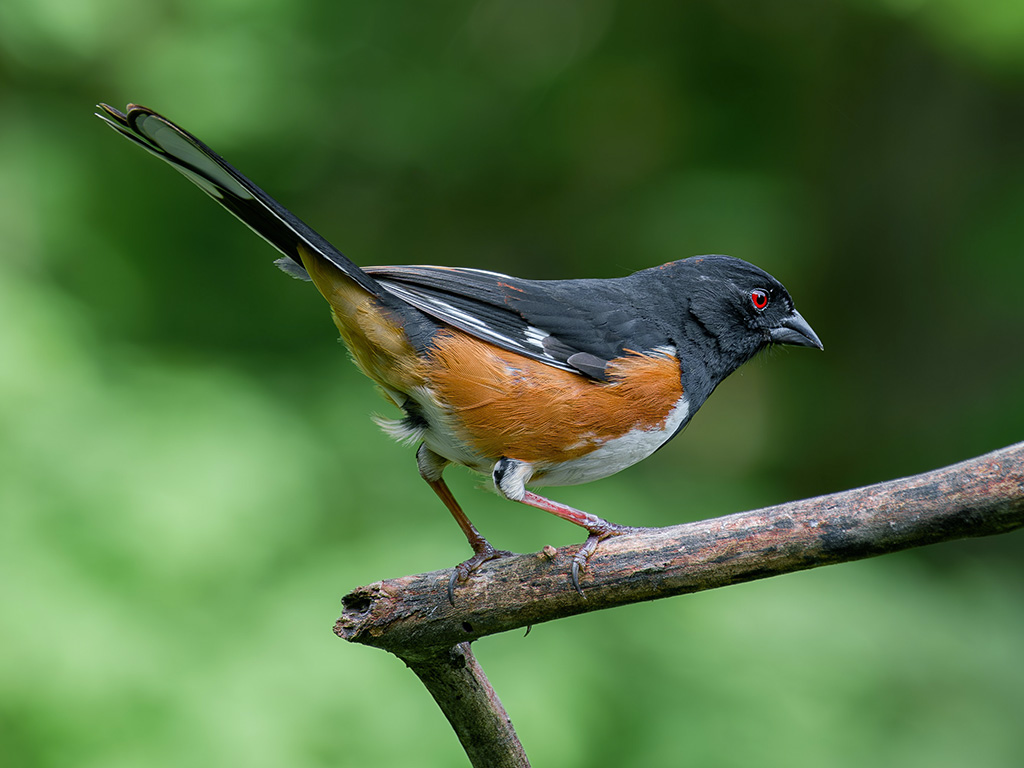
The eastern towhee is a species of sparrow native to North America. It is a large bird with a wingspan of up to 18 inches and a length of around 7 inches. Its plumage is dark, with a gray-brown back, white underparts, and a white belly.
The head has a distinct black-and-whiteite pattern, and the wings are white with light brown spots. The taxonomy of the eastern towhee has been debated in recent decades.
Historically, the eastern towhee and the spotted towhee were thought to be a single species, known as the rufous-sided towhee.
However, more recent evidence has led to the conclusion that the two species are distinct and should be treated as such. The eastern towhee is found in brushy areas across eastern North America, from Mexico to Canada.
It prefers dense undergrowth and shrubby areas and is often found near the edges of woods and clearings. It feeds on insects, berries, and seeds, and nests in low tangles of vines, shrubs, and trees.
| Kingdom | Animalia |
| Phylum | Chordata |
| Class | Aves |
| Order | Passeriformes |
| Family | Passerellidae |
| Genus | Pipilo |
| Species | P. erythrophthalmus |
Conclusion
Red birds are a common sight in Vermont. Fulbright feathers and cheerful chirps add beauty and life to the Vermont landscape.
Red birds can be found in many parts of the state, from cities to rural areas, and they are known for their lively presence and friendly nature.
Whether you are a resident of Vermont or just visiting, be sure to take a moment to appreciate the beauty of the red birds that make their home in the Green Mountain State.